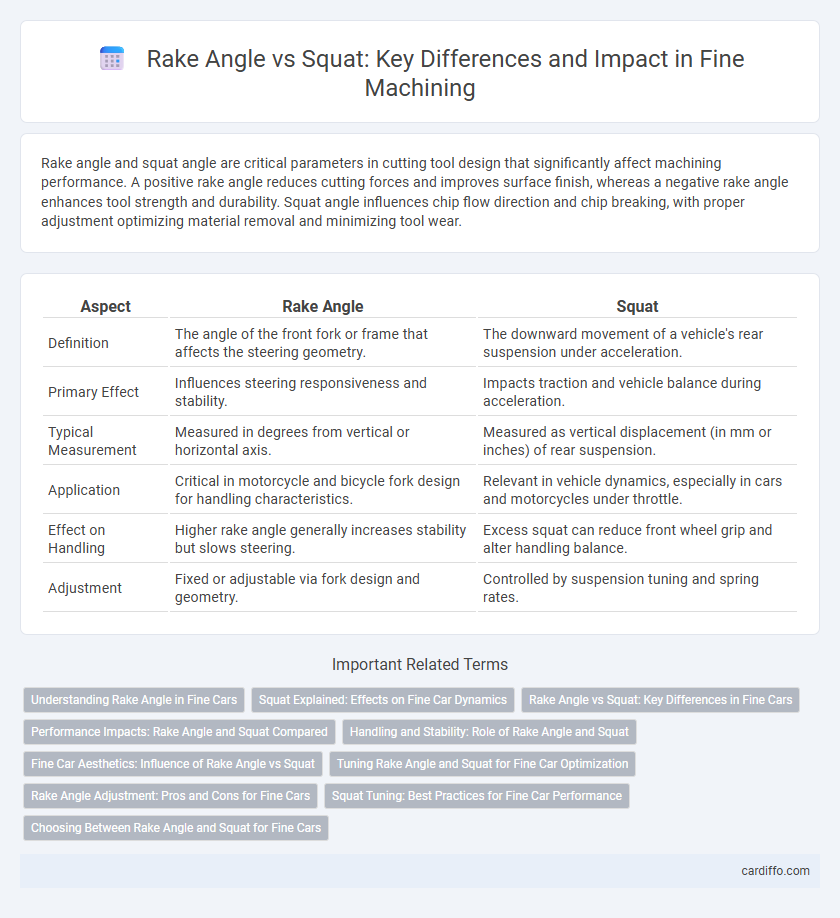Rake angle and squat angle are critical parameters in cutting tool design that significantly affect machining performance. A positive rake angle reduces cutting forces and improves surface finish, whereas a negative rake angle enhances tool strength and durability. Squat angle influences chip flow direction and chip breaking, with proper adjustment optimizing material removal and minimizing tool wear.
Table of Comparison
| Aspect | Rake Angle | Squat |
|---|---|---|
| Definition | The angle of the front fork or frame that affects the steering geometry. | The downward movement of a vehicle's rear suspension under acceleration. |
| Primary Effect | Influences steering responsiveness and stability. | Impacts traction and vehicle balance during acceleration. |
| Typical Measurement | Measured in degrees from vertical or horizontal axis. | Measured as vertical displacement (in mm or inches) of rear suspension. |
| Application | Critical in motorcycle and bicycle fork design for handling characteristics. | Relevant in vehicle dynamics, especially in cars and motorcycles under throttle. |
| Effect on Handling | Higher rake angle generally increases stability but slows steering. | Excess squat can reduce front wheel grip and alter handling balance. |
| Adjustment | Fixed or adjustable via fork design and geometry. | Controlled by suspension tuning and spring rates. |
Understanding Rake Angle in Fine Cars
Rake angle in fine cars refers to the inclination of the car's body relative to the ground, influencing aerodynamic performance and aesthetic appeal. A proper rake angle improves airflow under the vehicle, reducing squat--the rearward lowering of the car during acceleration--and enhancing stability and traction. Optimizing rake angle minimizes rear-end squat, ensuring better handling and maintaining the fine car's dynamic balance.
Squat Explained: Effects on Fine Car Dynamics
Squat in fine car dynamics refers to the rear suspension compression that occurs during acceleration, causing the rear end to lower and affecting traction and stability. Unlike rake angle, which is the tilt of the car's chassis for aerodynamic benefits, squat directly impacts weight transfer and grip on the rear wheels. Managing squat is essential for optimizing acceleration performance and maintaining control in high-speed fine car maneuvers.
Rake Angle vs Squat: Key Differences in Fine Cars
Rake angle in fine cars refers to the inclination of the vehicle's body relative to the ground, impacting aerodynamics and handling, while squat describes the rear suspension's downward movement during acceleration. Higher rake angles can improve aerodynamic efficiency, but excessive squat affects stability and tire contact, reducing traction. Optimizing the balance between rake angle and squat enhances performance by maintaining effective weight distribution and minimizing drag.
Performance Impacts: Rake Angle and Squat Compared
Rake angle significantly influences squat performance by affecting the contact patch and traction during acceleration and deceleration phases. A steeper rake angle enhances stability and grip, optimizing handling and reducing squat under heavy load conditions. In contrast, a shallower rake angle may increase squat, compromising performance by shifting weight distribution unfavorably and diminishing overall control.
Handling and Stability: Role of Rake Angle and Squat
Rake angle significantly influences motorcycle handling and stability by determining the steering geometry and front-end responsiveness, with a steeper rake angle enhancing stability at high speeds but reducing maneuverability. Squat, the rear suspension compression under acceleration, affects traction and weight distribution, directly impacting cornering stability and grip. Optimal balance between rake angle and squat maintains precise handling while ensuring maximum stability during varied riding conditions.
Fine Car Aesthetics: Influence of Rake Angle vs Squat
Fine car aesthetics are significantly shaped by the rake angle and squat, where a steeper rake angle enhances the vehicle's aggressive stance and aerodynamic flow, creating a dynamic and sleek profile. Squat, characterized by the rear of the car sitting lower than the front, conveys power and stability, complementing the rake angle to refine overall visual balance. Meticulously tuning these elements is crucial for automotive designers aiming to merge performance cues with visually appealing proportions.
Tuning Rake Angle and Squat for Fine Car Optimization
Optimizing the rake angle directly influences the squat behavior by adjusting the car's aerodynamic balance and suspension dynamics, enhancing traction and stability during acceleration and cornering. Precise tuning of the rake angle allows fine control over weight transfer, minimizing squat effects that can compromise grip and tire wear. Incorporating suspension stiffness, ride height, and shock absorber settings in tandem with rake angle adjustments achieves optimal squat reduction, resulting in improved overall vehicle performance.
Rake Angle Adjustment: Pros and Cons for Fine Cars
Rake angle adjustment in fine cars significantly impacts squat behavior during acceleration and deceleration, influencing vehicle stability and traction. Increasing the rake angle can reduce rear squat by shifting weight distribution forward, enhancing handling precision but potentially compromising rear tire grip under heavy throttle. Conversely, a lower rake angle maintains rear tire contact, improving acceleration traction but risking increased squat that may destabilize fine car dynamics.
Squat Tuning: Best Practices for Fine Car Performance
Squat tuning optimizes vehicle stability during acceleration by adjusting suspension settings to control rear-end squat, enhancing tire grip and traction. Fine-tuning the rake angle in relation to squat balances aerodynamics and mechanical grip, improving overall car performance on track. Precise adjustments in shock stiffness and spring rates tailored to the rake angle ensure minimal squat without compromising ride quality or handling.
Choosing Between Rake Angle and Squat for Fine Cars
Fine cars require precise tuning of rake angle and squat to optimize handling and performance. Adjusting the rake angle affects weight distribution and aerodynamic balance, enhancing cornering stability, while squat influences rear suspension compression during acceleration, improving traction. Choosing the right combination depends on the specific suspension geometry and driving conditions to achieve a harmonious balance between grip and responsiveness.
Rake angle vs Squat Infographic

 cardiffo.com
cardiffo.com